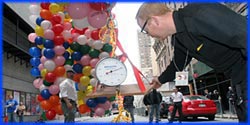


Premier Date: January 10, 2015
The myths in this episode came from the animated series The Simpsons. Executive producer Al Jean made an appearance.
plausible
Adam built a full-scale model of Homer Simpson with dimensions accurate to the show, including a height of 5 feet 11 inches (180 cm) and a weight of 239 pounds (108 kg). He shaped and sculpted upholstery foam to form the body and used a mold to form a foam head. He and Jamie then covered the model with latex and painted it to look like Homer. Immediately before the experiment, they filled the body with water to simulate Homer’s weight and body density.
Jamie built a supersized wrecking ball with steel-reinforced concrete. He formed two halves of the ball by digging hemispherical holes in the ground and using them as molds for the concrete. After curing, the two halves were joined together and the resulting ball was 5 feet (150 cm) in diameter and weighed 5,000 pounds (2,300 kg).
Next, the MythBusters crew built two simulated houses by erecting end walls with structural bracing and an exterior masonry chimney. The wrecking ball was pulled back 12 feet (3.7 m) and swung at one of the walls to evaluate the damage without Homer hanging on. The impact caused severe buckling and knocked the top portion of the chimney loose. When Homer was attached to the ball and it was swung at the other wall, the wall flexed and the chimney cracked, but there was much less visible damage, so Adam and Jamie classified the myth as plausible.
busted
Adam built three small-scale toilets with working plumbing and a transparent window to display how the water flowed inside. The plumbing system allowed connections at different points to introduce a pressure surge. Jamie used a pneumatic soda-can launcher to provide a surge of air pressure measuring 20 pounds per square inch (140 kPa). Repeated surges at different points in the plumbing system all sent a simultaneous burst of water from all three toilets. By placing a clog in the pipes and filling them with additional water, they were able to generate a larger gusher of water from the toilets.
To test this myth at full scale, Adam and Jamie built a platform at the bomb range and mounted three toilets on it with shared steel plumbing. To first demonstrate that a fuse can burn under water, they made a cherry bomb with a long fuse, placed it in a bucket of water, and lit it. The fuse continued burning underwater because fuses contain an oxidizer in addition to fuel.
With the pipes clogged, Adam and Jamie placed a bomb at the midpoint of the shared piping and set it off. The explosion sprayed a small amount of water up but it also blew all three toilets off their mountings. A second test, with the toilets bolted directly to the piping and the bomb re-positioned to the lowest point in the plumbing, led to the same result: the toilets all immediately cracked apart at their bases. Since they could not match the geysers of water seen in the Simpsons episode, Adam and Jamie judged the myth busted.
Previous: Episode 222: Airplane Boarding